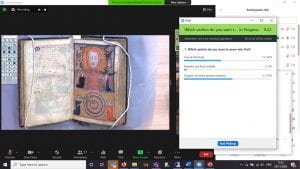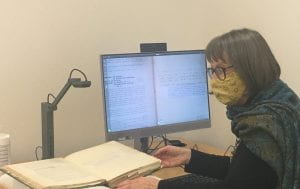This post by Moira Rankin and Robert Maclean (University of Glasgow) is the fourth in a series of reflections linked to the Research Resilience event organised by History UK and The National Archives’ Higher Education Archive Programme (HEAP). You can find out more about the panel discussion and networking event here.
A robust, future driven structure
The last year has been professionally challenging and rewarding for the Archives & Special Collections staff at the University of Glasgow. When the campus closed, our Team was already in the midst of change. A functional re-organisation had taken place in October 2019[1] to bring a ‘robust and “future driven structure”’ to meet the complex and ever-changing requirements of the 21st century academic community.[2] By March 2020 we were in the early stages of forming our team, scoping client needs, plotting trends and thinking creatively about interdisciplinary approaches to the collections.
On reflection that gave us a head start and we were able to put our online service ideas into practice far faster than we would ever have planned. Through lockdown we continually refocussed on what we could still do to keep research and teaching moving. A year on, the indications are that this approach has benefitted the University of Glasgow community.
Towards a post-custodial collaborative approach
In a recent podcast, scholar Karen Roybal commented on the limitations of custodial models of archival science. She spoke of the ways traditional methods have stifled some narratives and limited archivist professional development.[3] We were set in our ways so something had to change. The last year has changed the ways we communicate and collaborate – this is partly driven by the internal service change with archivists, conservators and librarians working closely together to offer a single point of contact collections teaching service.[4] But it is more than that – we are collaborating closely with our users to design the digital offer.
While it is too early to draw conclusions about the exact reasons for the change, what we can safely say is that during an uncertain budgetary environment, our management chose to invest over £30,000 in technology to support what we called the Virtual Collections Classroom (VCC) and the Virtual Reading Room (VRR). The conversations with academic colleagues that built these services gave us a shared focus and common student experience centred purpose. The break in the routine caused by the pandemic has enabled us to be creative about service delivery beyond our physical campus spaces.
New online services

We knew of visualiser set ups that had successfully been used by individual teachers and wanted to build something around that.[5] Our learning technology colleagues suggested we look at a ceiling mounted camera being used by anatomy lecturers in Dundee and St Andrews for over-the-shoulder teaching. With the input of academic colleagues,[6] in under 3 months we successfully made the business case for investment, installed the equipment, drew up conservation processes and user guides and turned it into a fully functioning bookable service.
Twenty-one visualiser classes were delivered to over 700 students from first year undergraduates right through to postgraduate researchers. User feedback from teachers and students was incredibly positive. Three of the teachers who used it received five nominations between them for teaching awards. Dr Johanna Green, whose strong support for the concept helped secure the required technological investment, won the award for Best Practice in Online Learning.
Visualisers and research
During the more open phases of lockdown the Virtual Reading Room service provided a form of access for those who were shielding and those who were studying or working away from Glasgow. Moreover it allowed academic teaching staff to save time (and stay safe) by limiting the number of visits to campus. They could do their teaching research from home. Finding ways to make teaching preparation more efficient has the potential to release more research time. This is something we will continue to investigate post-pandemic.

Visualiser technology allows viewers to get a sense of scale, of materiality (through zooming in on physical features and studying condition and quality of materials), and a general sense of the “thingy-ness” of the object. Yet we are clear that this does not replicate a traditional research visit experience. It offers a quick flavour of the research object and the chance to confirm discrete and specific questions about it – such as, “yes, I’d like to have this digitised” or “no, I will not travel across the world to view it in person”. Careful management of user expectation of this new service continues to be important.
In a post-pandemic world visualiser-mediated access will be part of our service portfolio. Services might include:
- A “try before you buy your plane ticket” service for distant researchers
- A more inclusive service for anyone who cannot visit for reasons of disability or caring responsibilities
- A conference call service allowing multiple researchers to consult items simultaneously over Zoom for project scoping and rapport building
- Exciting but secure “reveals” for book launches
- A high quality film studio environment for creating content for use in evidencing research findings and engaging audiences for enhanced impact
Resilient researchers of the future
We know there is strong demand for these services and we are still working through the post pandemic resource implications. Nevertheless we think that the most significant impact of this technology for research resilience may not be an immediate one.
Practical and logistical barriers have traditionally made it difficult to extend primary source teaching to the large undergraduate student cohorts. Postgraduate research students have sometimes reported archive anxiety and a lack of confidence in handling primary sources for the first time. Visualiser technology has enabled archive and rare book sources to go directly into an online first year class of Economic & Social Historians this year. They enthusiastically used the Zoom chat function to share their thoughts. Will the historians who started during the pandemic have a fresh perspective having seen their lecturers interacting with their source in real time? Will this inspire them to challenge and develop the subject in new ways? What previously hidden or marginalised perspectives might be revealed? Time will tell.[7]
References
- University of Glasgow – MyGlasgow – Archives & Special Collections – Our team. This paper covers the work that was led by the Engagement Team. It does not cover other future facing developments being led by other teams. The development of a new collections discovery interface is being led by Sarah Hepworth and the development of a Digital Preservation service by Clare Paterson.
- Restructuring for relevance: a paradigm shift for academic libraries | Emerald Insight
- Interview with Karen Roybal, 23rd February 2021 in Objectivity and Neutrality in the Archive, a podcast on Anchor
- The ASC Conservation & Preservation Team, led by Julie Gardham, have contributed enthusiastically to deliver this service professionally and securely.
- The work of Dot Porter at The University of Virginia and Aaron Pratt at the University of Texas at Austin influenced the creation of our visualiser services.
- We would particularly like to thank our colleagues Johanna Green, Hannah-Louise Clark, Maria Economou, Catriona MM Macdonald and Adele Redhead for their enthusiastic support of our work this year.
- Our next step is to assess and frame the potential of this creative and engaging online learning environment using the SCALE tool produced by Carmen Richardson and Punya Mishra. https://doi.org/10.1016/j.tsc.2017.11.004
You must be logged in to post a comment.